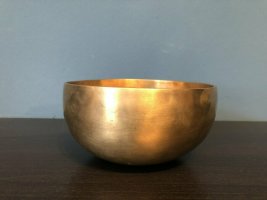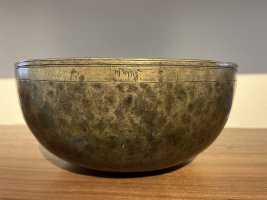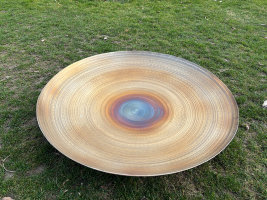Singing Bowls
GongZeit only sells handcrafted, personal selected, first quality Singing Bowls with over 25 years of experience in the music and instrument business. All my Singing Bowls are picked - piece by piece - by myself. That´s the only way to guarantee highest quality, because every Singing bowl in my shop is a handmade and unique piece of art. For any questions please contact us.
Which singing bowl is right for me? Which singing bowl should I buy?
It depends on what you want to use the singing bowl for. If it is intended primarily for yourself, let yourself be guided by the sound and the feeling that each bowl conveys along with its vibration. Be sure to pick it up, play it and feel it inside yourself. Each handcrafted singing bowl contains a variety of sounds, never just one tone. Make sure you have a harmonious overall feeling. The sounds should simply do you good and the vibration that you feel when you play a singing bowl on your body should also be pleasant and comforting. Some people find powerful vibrations and deep sounds pleasant, others prefer subtle, delicate sounds. Try it out. But make sure that the bowls are handmade. One clue is the long finish. Only by hammering (driving) the hot blank, which is made of a high-quality bronze alloy, does the great variety of sounds and the ever-resonating sound of relatively thin-walled singing bowls arise.
If you want a singing bowl for a facility (kindergarten, school...) or for special applications (sound massages, wellness area, sauna, yoga...), there are various criteria that you should take into account when making your decision. You can read more about it here to get a good impression and feel free to write or call us if you have any questions.
Where does the singing bowl come from?
The exact origin of the singing bowl cannot be reliably traced back. However, it is assumed that it was developed along the Himalayan mountains and found its way from there to all parts of the world. Local people used them as eating utensils, for example, which is why the singing bowls have always been made of very high-quality alloys, but also for shamanic rituals. In Buddhism, they were used as offering or begging bowls.
Some historians claim that singing bowls were first produced in India. However, there is also the theory that the invention cannot be traced back to a single culture, but that the bowls emerged almost simultaneously in different regions of Asia independently of each other. For example, they could have been used as alchemical tools in medicine or as traditional vessels in Hinduism. The first mention of the singing bowl by name dates back to the 8th century AD and can be found in Buddhist writings.
How are singing bowls made?
A singing bowl is made of a metal alloy. How this is put together depends on what acoustic properties the bowl should have. Common ones are copper, nickel, tin, zinc and a wide variety of precious metals, which are added in traces depending on the region. The metals are liquefied in a melting furnace and mixed together in the correct proportions. The resulting alloy is then cast into a blank: the result is a round, usually cylindrical lump that first has to cool and harden.
Then the complex forging process begins. The lump of metal is repeatedly heated and, depending on the size of the bowl, hammered into the bowl shape by hand by one or more workers. This process is repeated until the basic shape and desired wall thickness of the shell is achieved. Every singing bowl that is made using this process is unique and has its own special sound. The bowl is then polished and the surface is smoothed. If you want to change the sound of it, remove material from the inside until the desired harmony is achieved.
Basically, after this procedure, the singing bowl is finished and you can buy it. However, optional decorations such as engravings are possible to visually enhance the vessel. Of course, quality control should not be missing either. This ensures that your bowl is free of defects and sounds the way it should sound. But of course we'll take care of that for you.
How does the singing bowl work? This is how you play them correctly
Take the clapper in your dominant hand (the left for left-handed people and the right for right-handed people) and hold it as loosely as possible. One side is held in place by your thumb and the other by your index and middle fingers. The bowl itself is best positioned on the flat underside of your hand. Alternatively, you can place it on a pillow or another soft surface.
When you strike, what matters is how much energy you use. Find out what sounds harmonious to you. A hit that is too hard will produce an unpleasant sound and a hit that is too soft will sound a bit weak. Ideally, approach the right intensity slowly. Make sure the clapper is parallel to the bowl and perform your movement with full awareness. Hit once and then let the bowl finish. The blows must not occur too quickly one after the other. Over time you will find your personal rhythm.

Singing bowl singing through friction
The quality of the singing bowl is even more important here. And of course there is also a bit of practice and technique involved. By rubbing the leather-covered wooden mallet along the edge, your singing bowl can be made to sing. This is where its international name comes from: singing bowl. At the beginning it is a little more difficult than just strumming and requires some practice and patience. Basically, you move the clapper across the top, outer edge of your bowl using light, even pressure. Always beautiful from the wrist. As if you were writing or drawing around the bowl. It is also important that your other hand, on which the singing bowl lies, remains completely relaxed and flat and that you do not follow the impulse to want to hold it tighter. This makes “singing” more difficult or impossible.
At the beginning you can hit the bowl once to make it vibrate and then rub it into this vibration. This often makes it easier. If your bowl starts to clink, this indicates that you are either rubbing too quickly or have not applied enough pressure.
Don't be discouraged if you don't get the singing right on your first try. It takes some time until you develop an intuitive feeling for the optimal relationship between pressure, speed and posture angle. Once you have had your first positive experiences, you can try changing the direction of rotation, rubbing in semicircles and thereby bringing more dynamics to your singing.
Tones and frequencies
The tones and frequencies of singing bowls depend on the material used to make them, how large the bowl is and what shape it has. Small vessels generally have a higher fundamental tone and faster vibrations, while large vessels have lower fundamental tones and slower vibrations. As a rule, lower sound frequencies are perceived as more calming and softer and higher frequency ranges as more invigorating and clearer. If you want to buy the singing bowls for special applications, such as sound massages, relaxation seminars, signaling devices for lessons..., you should include these sound directions in your purchase decision. It's best to get personal advice so that you can fine-tune all aspects of what the singing bowl should be able to do.
When used with children, I would always recommend higher and medium pitches, as many children find these more pleasant compared to lower fundamental tones.
The feeling of frequencies and pitches is very subjective and if you want to choose a singing bowl for yourself, think about what it should give you, what it should support you in and let your feelings have a say in the final decision. Experience has shown that this is a very good approach for sound objects.
There are many classifications and systems on the singing bowl market into which singing bowls are packed: chakras, body zones, planets... We only recommend buying the bowls that sound right for you and, if there are several, having them harmoniously coordinated with one another . Harmonies are omnipresent in sound and in our lives and have a very beautiful, positive effect on most people. They appeal to the emotions and not the head and that is what we expect from a suitable singing bowl (or several): They should touch you, do you good, relax you and make you feel good.
Find the right size
As far as size is concerned, the bowls differ not only in their sounds, but also in their areas of application (especially in sound massages). Lighter singing bowls (under one kilo) are usually used for the upper part of the body, heavier bowls (1 to 2 kilos) are used more in the lower area (pelvic bowls), especially because of their higher weight. A 2.5 kg bowl is rather uncomfortable for most people lying on their upper back. On the other hand, it feels good on the pool.
In general, medium-sized singing bowls (approx. 900 grams to 1.3 kg) are often referred to as universal bowls because they can be comfortably placed on the entire body. Very small bowls are called head bowls (approx. 300 to 500 grams), slightly heavier ones (600 to 900 grams) are called heart bowls. Singing bowls from 5 kg to 20 kg are often called foot bowls because you can place your feet in the bowl and the vibration of the bowl can spread through the body via the sensitive soles of your feet.
So think in advance what you want to use the bowl for. But here too, please don't just choose your singing bowls based on their assignments, but above all based on their sound!
Proper cleaning (past and present)
Since you touch your bowl with your hands, it is inevitable that dirt spots will form over time and the vessel will lose its shine. Traditionally, singing bowls were ritually rubbed with a mixture of mustard oil, ash and rice straw and thus cleaned. Or, if they were used as everyday eating utensils, they have been cleaned inside with sand and soap over years and decades. Which had the side effect that the interior of the shell thinned out naturally. This also had an audible effect on the sound. With the few really old singing bowls that you can still buy, this is very nice to hear and feel. We recommend that you use a bronze or brass polish or a gentle dishwashing liquid or brass cleaning milk for your singing bowls.
You should avoid sponges and brushes, otherwise you will scratch the metal. Be careful not to apply too much pressure and instead rub several times with gentle movements. How often you clean the singing bowls is entirely up to you. Depending on use, we recommend cleaning them once every 3 to 4 weeks, especially the outside.
What areas of application are there?
Singing bowls are often used in yoga. For example, you can place it on your tailbone during downward dog position. If you perform the “cobra”, the vessel can be placed on your lower back and struck there. If you vibrate your singing bowl before the exercises, you prepare your mind for what is to come and take the frequency with you into the exercise.
Singing bowls also have the ability to support meditation. Follow the sound of the bowl until it is no longer noticeable... Its long-lasting sound sequence reduces stress, ensures relaxation and calms your breathing. In addition, the acoustics give you an anchor point on which to focus your consciousness. Other areas of application include singing bowl therapy, which can lead to an improvement in body awareness and relief of various complaints (pain therapy, reducing emotional blockages...).
Special singing bowls for children can protect against stress and increase awareness of mind and body. The children learn to concentrate better and relax. The singing bowl massage is also particularly popular. As the vibrations flow through the entire body, they release blockages and create a feeling of harmony and serenity.


